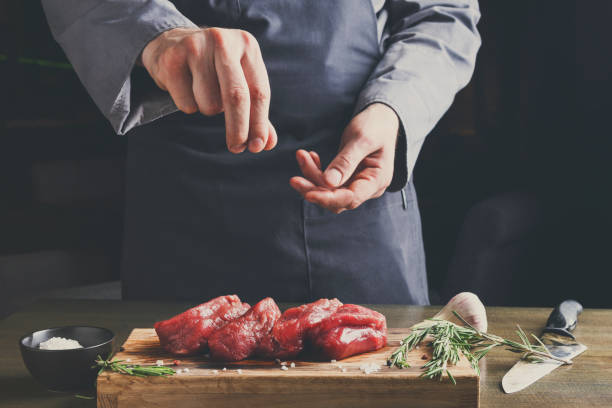Learning to cook steak to perfection takes time but with a few simple techniques and the right seasoning, you can create a Morton’s Steakhouse – quality steak in the comfort of your own home.
The Importance of Seasoning
The secret to a juicy and tender steak lies in proper seasoning. Here are a few musts when it comes to seasoning your steak:
- Season Well – Red meat can handle more salt than you might think. Don’t be afraid to generously season your steak with kosher salt. Ensure that the salt penetrates inside the meat, not just on the surface.
- Let it Rest – After cooking, allow your steak to rest. This allows the juices to redistribute throughout the meat, resulting in a more flavorful and succulent steak. Avoid rushing this step to prevent losing the juices when you slice into the steak.
- Use a Thermometer – To ensure your steak reaches the desired level of doneness, use a meat thermometer. This quick and easy tool will give you accurate temperature readings, ensuring perfectly cooked steak every time.
Choosing the Right Seasonings
When it comes to seasoning steak, simplicity often reigns supreme. Here are some classic seasonings you can use:
- Black Pepper and Kosher Salt – You can’t go wrong with the classic combination of freshly cracked black pepper and kosher salt. These two ingredients enhance the natural flavors of the meat and create a delicious crust.
- Flavored Salt – Add depth of flavor to your steak by incorporating chopped herbs such as thyme, rosemary, or sage into your kosher salt. This flavored salt will elevate the taste of your steak and impress your taste buds.
- Butter and Herb Basting – For a restaurant-quality touch, baste your steak with butter and herbs during the final moments of cooking. This imparts a delightful buttery flavor reminiscent of your favorite steakhouse.
- Custom Spice Blend – Experiment with a personalized spice blend by combining dried seasonings like onion powder, garlic powder, rosemary, smoked paprika, thyme, chile powder, cumin and brown sugar. Store your blend in an airtight container for easy access whenever you need it.
Mastering the Cooking Process
Now that your steak is properly seasoned, let’s explore some cooking techniques to achieve a mouthwatering result:
- Reverse Sear – This popular method allows for hands-free cooking and even doneness. Start by cooking your steak in the oven at a lower temperature and then finish with a quick sear on the stovetop to create a beautiful crust.
- Broiling – For a fantastic crust, sear your steak on the stovetop and then finish it under the broiler in your oven. This replicates the delectable crust you would find at a steakhouse.
- Create Heat Zones – When grilling, create different heat zones on your grill. This allows you to move the steak to different areas depending on its desired doneness. If your steak is cooking too quickly, move it to a cooler part of the grill. Conversely, if it needs more cooking, move it to a hotter zone.
Debunking Common Steak-Cooking Myths
Let’s address some common misconceptions when it comes to cooking steak:
- High Heat Searing – While high heat searing creates a beautiful crust, it doesn’t directly impact the steak’s juiciness. Juiciness is primarily determined by the cut of meat and the cooking method used. To avoid dryness, start with a cooler zone when grilling larger cuts and finish in a hotter zone to caramelize the exterior.
- Flipping – Don’t fear flipping your steak. Flipping and rotating the steak during cooking allows you to control the distribution of heat. If one side is cooking faster than the other, flipping helps achieve even doneness.
- Finger Test for Doneness – While the finger test can give you a rough idea of the steak’s doneness, it’s not as universally accurate as using a meat thermometer. Everyone’s hands and perception of touch differ, making a thermometer a more reliable tool for achieving your desired level of doneness.
The Final Steps
After properly seasoning and cooking your steak, follow these final steps for a truly satisfying dining experience:
Allow your cooked steak to rest on a cutting board. Tent it loosely with foil to retain heat while resting. Resting the steak for approximately half the cooking time ensures that the juices redistribute throughout the meat, resulting in a more flavorful and tender steak.
Then slice the steak against the grain. This is important to further enhance its tenderness. Lastly, serve it with your favorite sides.
Here’s how to do a reverse sear method for your steak:
